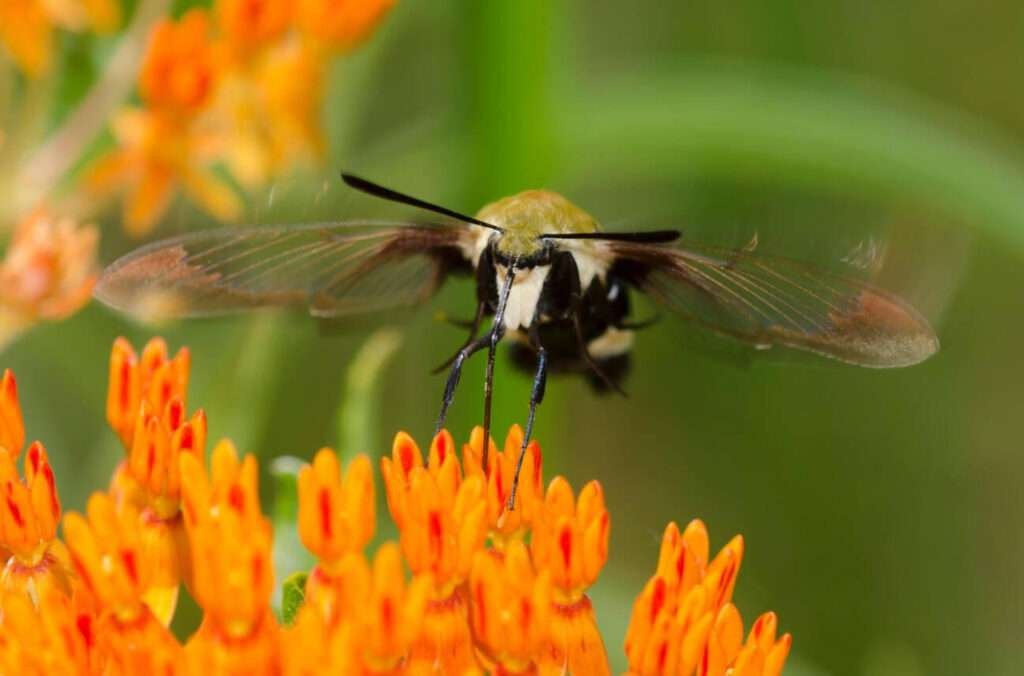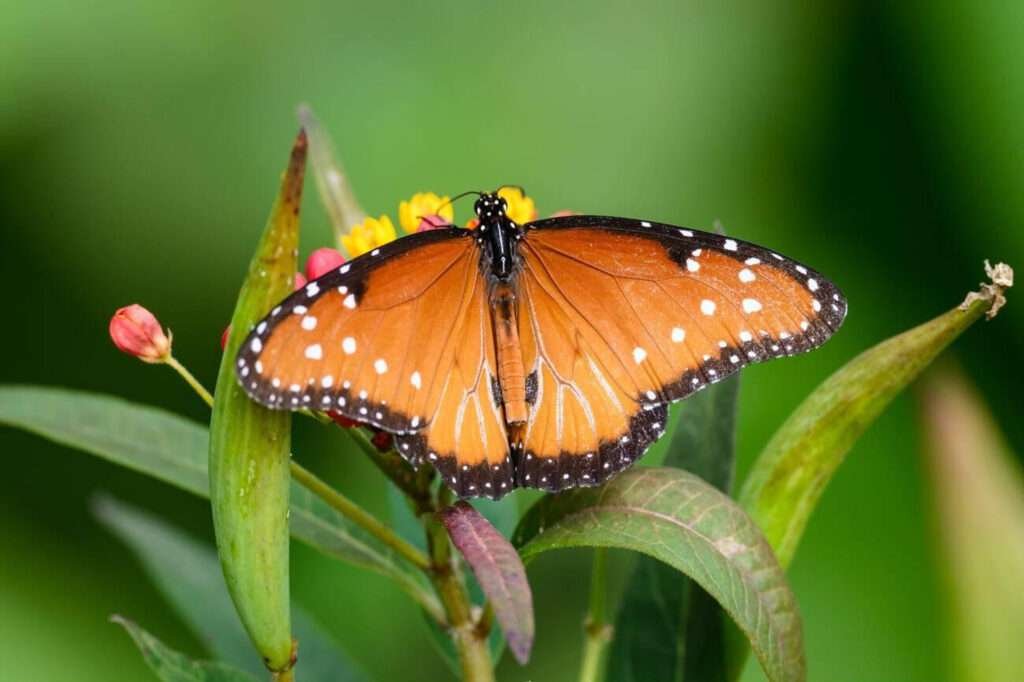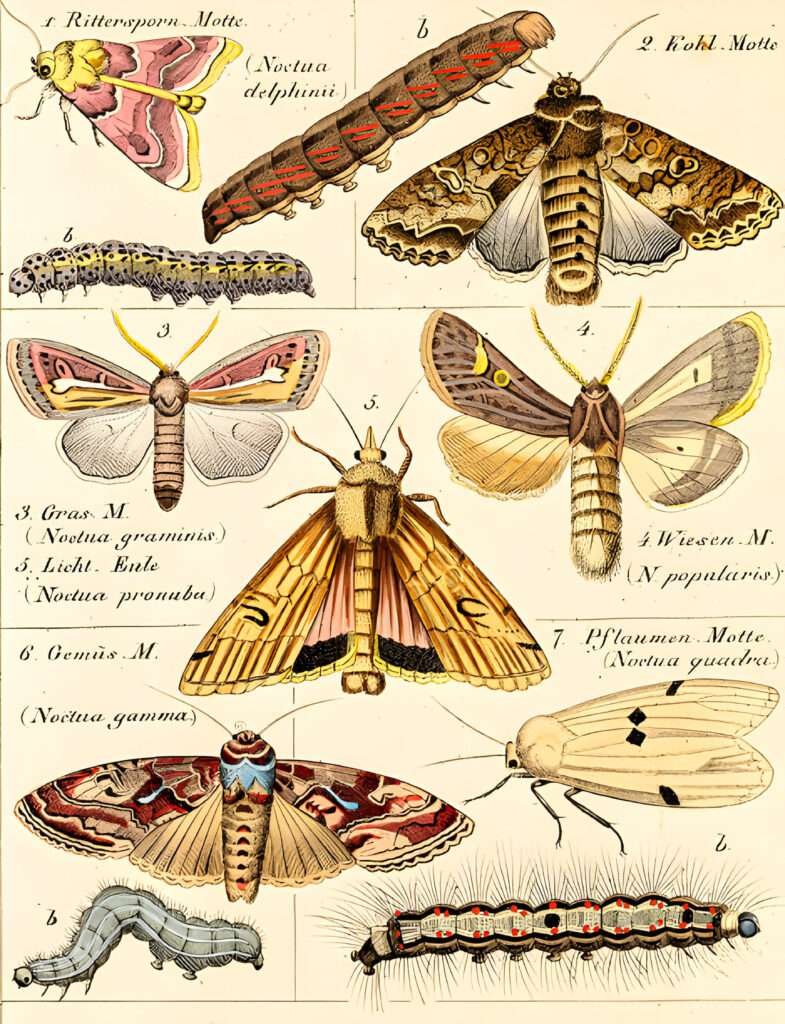Hemaris diffinis, commonly known as the Hummingbird Clearwing Moth, is a species of sphinx moth notable for its daytime feeding habits and hummingbird-like behaviour.
The Hummingbird Clearwing Moth is a fascinating creature that bridges the world of birds and insects. Found primarily in gardens and meadows throughout North America, these moths are often mistaken for hummingbirds due to their similar size and feeding habits.
With an approximately two-inch wingspan, they hover in mid-air, sipping nectar from various flowers with their long proboscises. This moth’s ability to hover and its transparent wings contribute to its unique appearance and intriguing behaviour, making it a subject of interest for amateur naturalists and professional entomologists.
Introduction To Hemaris Diffinis
Hemaris diffinis, often known as the Hummingbird Moth, is a unique species of sphinx moth. It earns its nickname for its remarkable resemblance to hummingbirds. This moth is a delight to both casual observers and entomologists alike. Its ability to hover and its rapid wing movement set it apart in the insect world.
The Enigma Of The Hummingbird Moth
The Hummingbird Moth is a marvel of nature. It shares many characteristics with actual hummingbirds, including a long proboscis to sip nectar and a fondness for brightly coloured flowers. Their wings beat incredibly fast, making a soft buzzing sound, which often leads to mistaken identity. They are daytime feeders, which is unusual for moths.

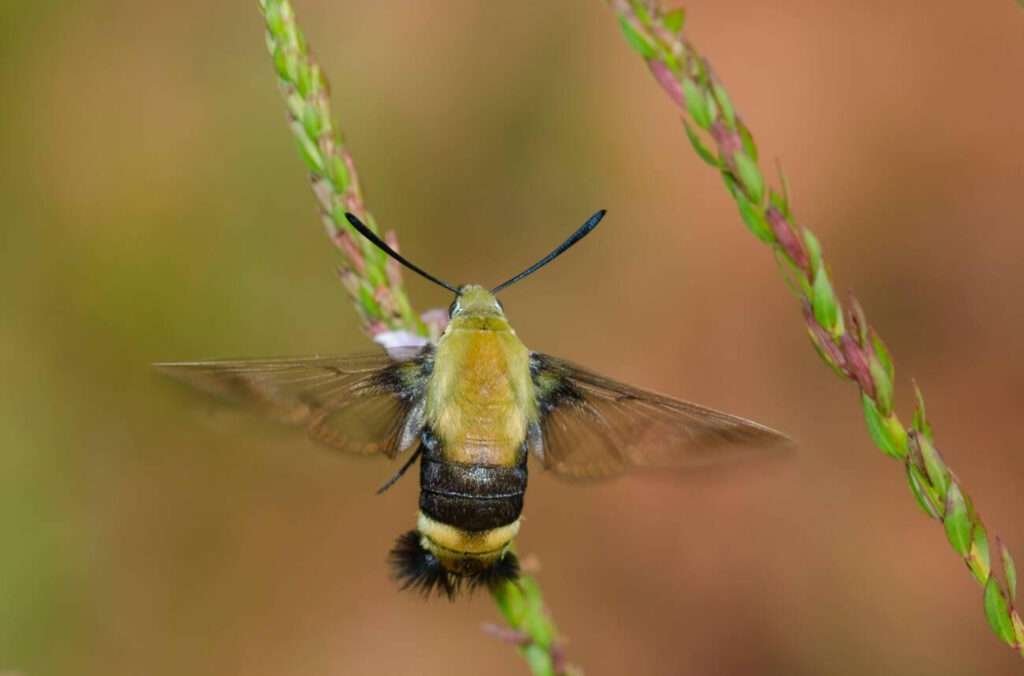
Spotting Hemaris Diffinis In The Wild
To see Hemaris diffinis, look in gardens or fields. These moths prefer sunny, open areas with plenty of flowers. They are most active from late spring through early fall. Their favourite flowers include honeysuckle, beebalm, and phlox. Catching a glimpse of these agile fliers is a rare treat for nature enthusiasts.
- Search near flowers like honeysuckle and beebalm.
- Visit gardens or fields during warm, sunny days.
- Look for their rapid wing movement and hovering behaviour.
Morphological Marvels
Hemaris diffinis, commonly known as the Snowberry Clearwing, is a sphingid moth that captivates with its unique body structure. Let’s delve into the morphological marvels that make this species a wonder of nature.
Wings That Resemble Hummingbirds
One of the most striking features of Hemaris diffinis is its wings. These creatures have clear, membranous wings that beat rapidly. This allows them to hover in mid-air, much like hummingbirds. Their wing structure is not just for show. It provides them with exceptional agility in flight.
Adaptations in their wings enable them to navigate through gardens and meadows with precision. It’s no wonder they are often mistaken for their avian counterparts!
Coloration And Markings
The body of the Snowberry Clearwing is a marvel in itself. These moths stand out in their natural habitat with a distinctive olive and burgundy colour palette.
- Olive green hues adorn their backs.
- Their bellies display a softer yellow-to-white gradient.
- Burgundy markings add contrast and aid in camouflage.
These colours not only make them beautiful but also serve a purpose. They help Hemaris diffinis blend into the foliage, keeping them safe from predators.
Habitat And Distribution
The Hemaris diffinis, also known as the Hummingbird Clearwing, is a fascinating moth species. Its habitat and distribution are as unique as its appearance. This section delves into where this beautiful insect thrives and the extent of its global reach.
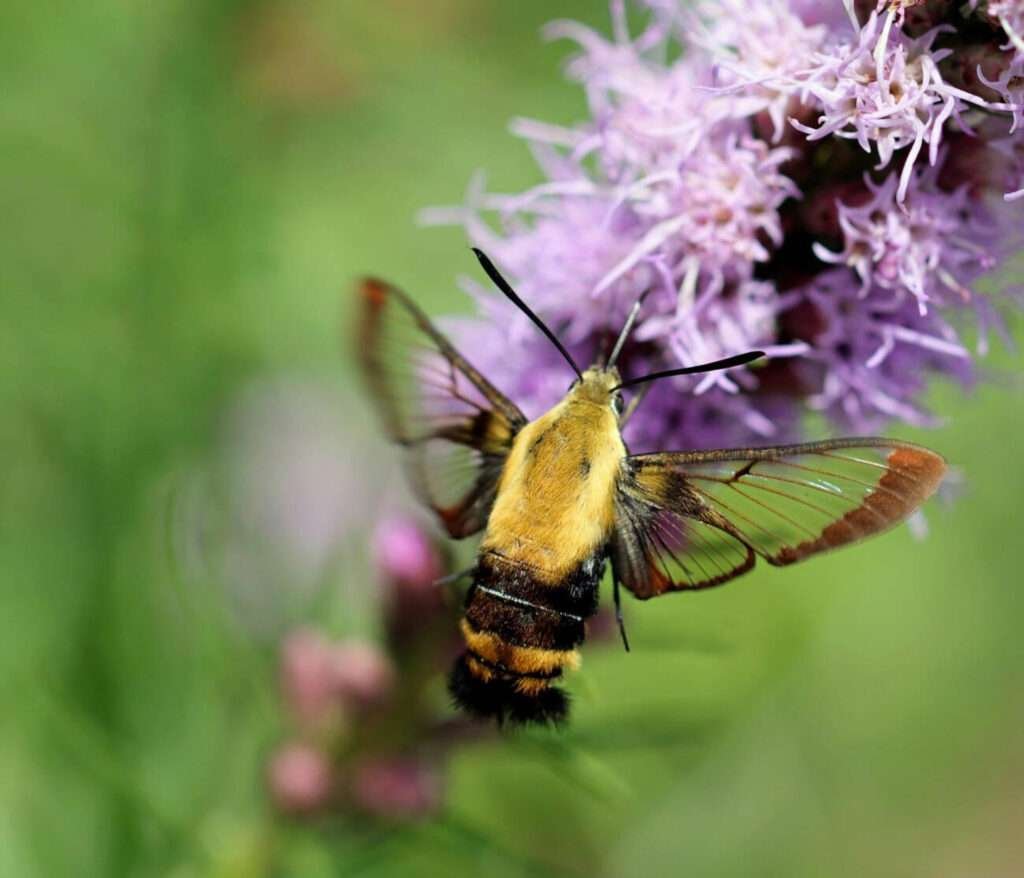
Preferred Environments
The Hemaris diffinis is fond of specific environments. It prefers sunny, open spaces where flowers bloom, including meadows, gardens, and forest edges. The moth is drawn to these habitats for their abundance of nectar sources, which are crucial for survival.
Geographical Range Across Continents
The geographical spread of the Hemaris diffinis is broad. It is primarily found in North America. Its range extends from Alaska to Florida, showcasing its adaptability to diverse climates. The species is also present in parts of Canada and Mexico, highlighting its extensive distribution across the continent.
| Summary of Hemaris diffinis Habitat and Distribution | |
| Environment | Location |
|---|---|
| Meadows and Gardens | North America |
| Forest Edges | Canada and Mexico |
Life Cycle Of The Hummingbird Moth
The Hemaris diffinis, known as the Hummingbird Moth, fascinates with its life cycle. This remarkable transformation from caterpillar to moth mirrors the breathtaking metamorphosis of butterflies. Understanding the life stages of this species offers insight into its survival and adaptability in various environments.
From Caterpillar To Moth
The journey of the Hummingbird Moth begins as an egg. The egg hatches into a caterpillar, which is the larval stage. During this time, the caterpillar feeds on host plants, growing rapidly. This phase is crucial for accumulating energy for the next stages.
- Larval Stage: Feeds voraciously on host plants.
- Pupal Stage: The caterpillar forms a chrysalis. Inside, it undergoes a remarkable transformation.
- Adult Moth: The fully formed moth emerges. It now has wings and can fly in search of nectar.
Once it emerges, the adult moth displays its beauty. Its wings beat swiftly, allowing it to hover like a hummingbird.
Seasonal Behavioral Patterns
The Hummingbird Moth adapts its behaviour to the changing seasons, ensuring the survival and continuation of the species.
| Season | Behaviour |
|---|---|
| Spring | Eggs hatch; caterpillars begin to feed. |
| Summer | Moths emerge, mate, and lay eggs. |
| Fall | Caterpillars form chrysalises to overwinter. |
| Winter | Chrysalises withstand the cold; moths are dormant. |
Each season brings new behaviours and challenges for the Hummingbird Moth, but its life cycle ensures that it thrives year after year.
Feeding Habits
The Hemaris diffinis, commonly known as the Snowberry Clearwing, has intriguing feeding habits. These habits significantly impact their ecosystem.
Floral Preferences
The Snowberry Clearwing shows a strong preference for certain flowers. This preference ensures they have access to their needed nectar.
- Phlox – they are attracted to its vibrant colours and shape.
- Honeysuckle – its sweet nectar is a favourite.
- Bee balm – it offers both nectar and a robust structure for landing.
Pollination And Its Ecological Role
Through their feeding, Hemaris diffinis play a crucial role in pollination.
As they move from flower to flower, they carry pollen on their bodies. This process helps in the reproduction of plants.
| Flower | Role in Pollination |
|---|---|
| Phlox | Enhances seed production |
| Honeysuckle | Supports genetic diversity |
| Bee balm | Aids in the growth of bee populations |
This activity supports biodiversity and maintains healthy ecosystems.
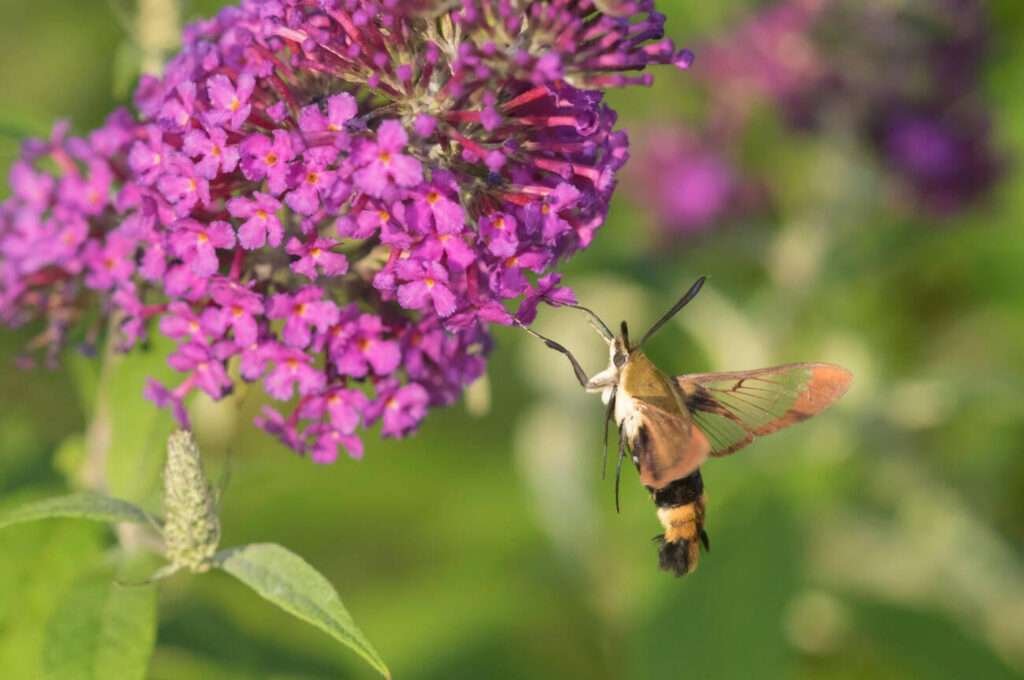
Mimicry And Defense Mechanisms
Understanding the mimicry and defence mechanisms of Hemaris diffinis, also known as the Hummingbird Moth, unveils a remarkable survival strategy. This moth has evolved unique features that confuse predators and ensure its survival.
Evolution Of Resemblance
Hemaris diffinis showcases a fascinating example of mimicry in nature. It closely resembles a hummingbird. This resemblance is not coincidental but a result of evolutionary adaptation. This adaptation helps it avoid many predators that hesitate to attack hummingbirds.
- Wing structure similar to hummingbirds
- Ability to hover over flowers
- Rapid wing movement
Predator Avoidance Strategies
The moth employs several strategies to stay safe from predators. Each strategy is crucial for its day-to-day survival.
- Colouration: Its body colour blends well with its environment.
- Flight patterns: Erratic and swift, making it hard to catch.
- Feigning death: When caught, it may play dead to escape.
These strategies collectively help Hemaris diffinis mimic and defend effectively in the wild.
Breeding And Reproduction
The cycle of life for the Hemaris diffinis, also known as the Hummingbird Clearwing Moth, unfolds through a fascinating breeding and reproduction process. This journey from mating rituals to the emergence of new moths is crucial for the species’ survival. Explore the intricate steps of their life cycle.
Mating Rituals
The dance of love for Hemaris diffinis begins with the male’s pursuit. Males hover in mid-air, displaying their agility to attract females. Once a female is interested, they join in a mid-flight coupling. This aerial ballet ensures the next generation of moths will thrive.
Laying Eggs And Larval Development
After mating, females lay eggs on the underside of host plant leaves. Each female can lay up to 200 eggs, ensuring many caterpillars hatch. These eggs are small, green, and hard to spot. They hatch into hungry larvae ready to feed on the host plants.
- Host plants include viburnum and hawthorn.
- Larvae eat leaves, growing rapidly.
- They pass through several stages called instars.
The larval stage is crucial for growth. The caterpillars shed their skins multiple times. Each stage brings them closer to becoming a pupa. The pupa stage is a time of transformation. Here, the caterpillar turns into a moth ready to start the cycle anew.
| Stage | Description | Duration |
|---|---|---|
| Egg | Female lays on host plants | 3-5 days |
| Larval | Caterpillar feeds and grows | 3-4 weeks |
| Pupal | Caterpillar transforms | 2-3 weeks |
Understanding the breeding and reproduction of Hemaris diffinis is key to conserving this unique species. Their life cycle is a reminder of the delicate balance of nature.
Conservation Status
The Hemaris diffinis, or the Hummingbird Clearwing Moth, is a species that captures the imagination with its bird-like appearance. Understanding its conservation status is crucial for preserving biodiversity. Let’s explore the current state of this enchanting moth.
Current Population Trends
Recent studies show that the population of Hemaris diffinis remains relatively stable. These moths are widespread across North America. They are adaptable to various habitats, which helps keep their numbers healthy. It’s important to monitor these trends to ensure their continued prosperity.
Threats To Survival
- Habitat Loss: Urban development reduces the natural spaces where these moths thrive.
- Pesticides: Chemicals used in agriculture can harm Hemaris diffinis, affecting their health and the plants they rely on.
- Climate Change: Altered weather patterns can disrupt the life cycle of these moths, leading to population decline.
Protecting Hemaris diffinis involves addressing these threats. Conservation efforts can help secure a future for this species.
Research And Observations
The world of moths is fascinating and diverse, with Hemaris diffinis standing out as a striking species. Known commonly as the Hummingbird Clearwing, this moth mimics hummingbirds in flight. This section delves into the research and observations that shed light on these incredible insects.
Scientific Studies On Hemaris Diffinis
Experts have conducted various studies to understand the behaviour and ecology of Hemaris diffinis. These studies focus on their pollination role and mimicry abilities. Let’s explore some key findings:
- Flight Mechanics: Research reveals how their wing structure supports their hummingbird-like flight.
- Mimicry: Studies suggest that their resemblance to hummingbirds might protect them from predators.
- Ecological Role: Hemaris diffinis is a vital pollinator for many flower species.
Citizen Science Contributions
Citizen scientists play a crucial role in tracking the spread and behaviour of Hemaris diffinis. They report sightings and share photos, aiding research greatly. Here’s how they contribute:
- Recording sightings help map their distribution.
- Photographs contribute to understanding their physical variations.
- Observation notes provide insights into their feeding habits.
These contributions enrich the scientific community’s knowledge of the species. Citizen science projects bring enthusiasts and researchers together to learn more about Hemaris diffinis.
Encountering Hemaris Diffinis
Imagine stepping into your garden and spotting a vibrant creature flitting among the flowers. This could be the Hemaris diffinis, also known as the Snowberry Clearwing or Hummingbird Moth. This moth resembles a hummingbird and is a delightful sight for gardeners and wildlife enthusiasts.
Photography And Identification Tips
Documenting the Hemaris diffinis is rewarding but can be tricky. These moths are fast and rarely stay still. To capture their beauty, use a camera with a high shutter speed. A macro lens is ideal for close-ups. Look for their distinct features:
- Wings: Transparent with reddish-brown borders.
- Body: Olive-green and burgundy with white stripes.
- Size: About 1.25-2 inches in wingspan.
Early morning or late afternoon provides the best natural light for photography. Remember to move slowly to avoid startling them.
Creating A Moth-friendly Garden
Attracting Hemaris diffinis to your garden is simple with the right plants. These moths love nectar-rich flowers. Include a variety of plants that bloom at different times to provide a constant food source.
| Plant Type | Examples | Blooming Period |
|---|---|---|
| Shrubs | Honeysuckle, Snowberry | Spring to Summer |
| Perennials | Bee balm, Phlox | Summer to Fall |
| Annuals | Petunia, Fuchsia | Spring to Fall |
Remember to avoid pesticides. They can harm these beneficial pollinators. A source of water and sheltering plants can also encourage them to stay in your garden longer.
Frequently Asked Questions
What Is The Difference Between Hemaris Diffinis And Hemaris Thysbe?
Hemaris diffinis, commonly called the Snowberry Clearwing, has a black band running through its wings, while Hemaris thysbe, known as the Hummingbird Clearwing, showcases a more olive and burgundy body colouration. Both are species of sphinx moths, often mistaken for hummingbirds.
Is It Rare To See A Hummingbird Moth?
Hummingbird moths are uncommon, but not extremely rare. Their sightings vary by location and season, often in gardens and near flowers.
What Plant Does Hemaris Diffinis Host?
The Hemaris diffinis, or Snowberry Clearwing moth, primarily hosts honeysuckle, snowberry, and dogbane plants.
Do Bumblebee Moths Sting?
Bumblebee moths, also known as hummingbird moths, do not sting. They are harmless and lack the ability to sting like bees.
Conclusion
Exploring the vibrant world of the Hemaris diffinis, we uncover the beauty and importance of these pollinators. Their role in our ecosystems is undeniable, and our gardens are more vibrant because of them. Embrace these winged wonders and the biodiversity they support.
Let’s safeguard their habitat for future generations to marvel at.


